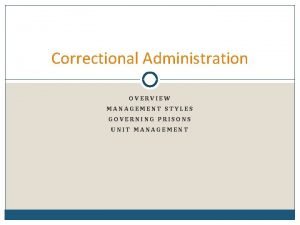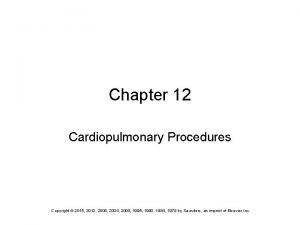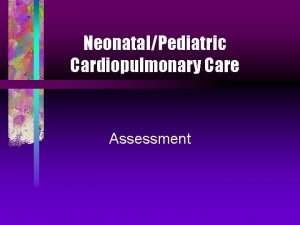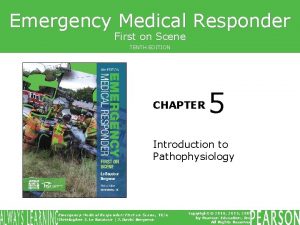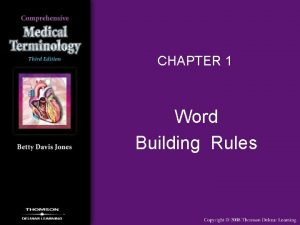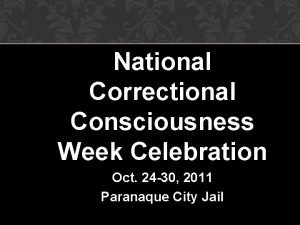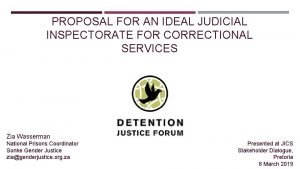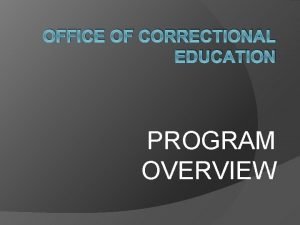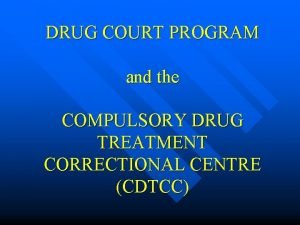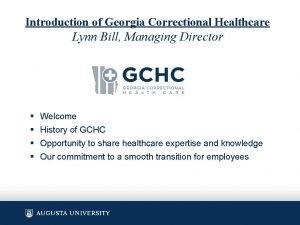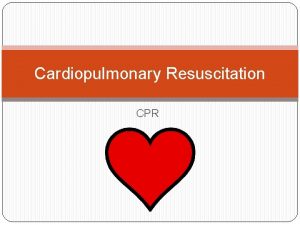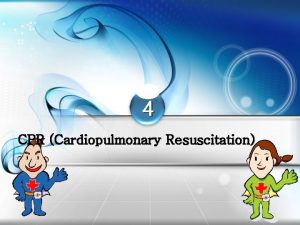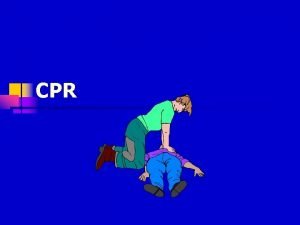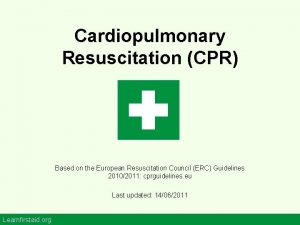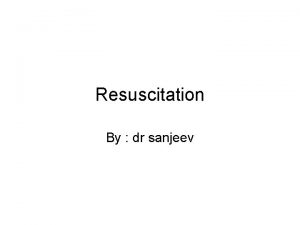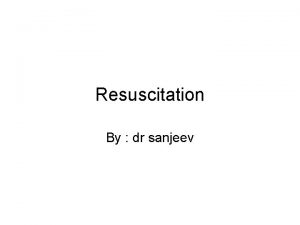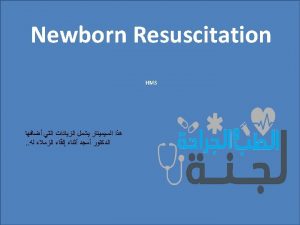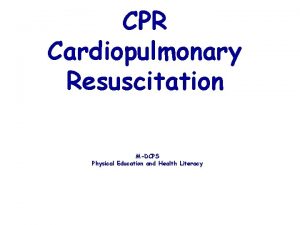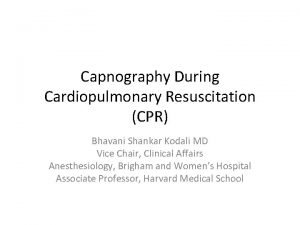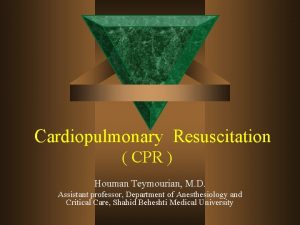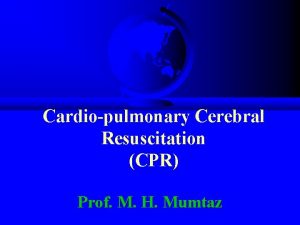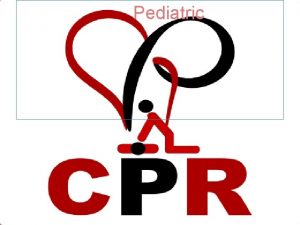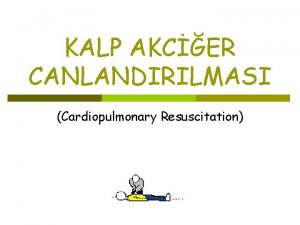Cardiopulmonary Resuscitation CPR in Correctional Facilities Copyright Texas


















- Slides: 18

Cardiopulmonary Resuscitation CPR in Correctional Facilities

Copyright © Texas Education Agency, 2017. These Materials are copyrighted © and trademarked ™ as the property of the Texas Education Agency (TEA) and may not be reproduced without the express written permission of TEA, except under the following conditions: 1) Texas public school districts, charter schools, and Education Service Centers may reproduce and use copies of the Materials and Related Materials for the districts’ and schools’ educational use without obtaining permission from TEA. 2) Residents of the state of Texas may reproduce and use copies of the Materials and Related Materials for individual personal use only, without obtaining written permission of TEA. 3) Any portion reproduced must be reproduced in its entirety and remain unedited, unaltered and unchanged in any way. 4) No monetary charge can be made for the reproduced materials or any document containing them; however, a reasonable charge to cover only the cost of reproduction and distribution may be charged. Private entities or persons located in Texas that are not Texas public school districts, Texas Education Service Centers, or Texas charter schools or any entity, whether public or private, educational or non-educational, located outside the state of Texas MUST obtain written approval from TEA and will be required to enter into a license agreement that may involve the payment of a licensing fee or a royalty. For information contact: Office of Copyrights, Trademarks, License Agreements, and Royalties, Texas Education Agency, 1701 N. Congress Ave. , Austin, TX 78701 -1494; phone 512 -463 -7004; email: copyrights@tea. state. tx. us. Copyright © Texas Education Agency, 2017. All rights reserved. 2

CPR Facts > Heart disease is the number 1 killer in the U. S. > 330, 000 Americans die yearly > 50% of these will die before they get to the hospital Copyright © Texas Education Agency, 2017. All rights reserved. 3

CPR Facts > The most common cause of death from a heart attack in adults is ventricular fibrillation > Ventricular fibrillation: • A disturbance in the electrical rhythm of the heart • Can be treated with defibrillation (applying an electrical shock to the chest) • If a defibrillator is not readily available, brain death will occur in less than 10 minutes Copyright © Texas Education Agency, 2017. All rights reserved. 4

CPR Facts > During cardiac arrest, the heart stops pumping blood. • CPR is one way of buying time until normal heart function is restored or a defibrillator becomes available. • CPR provides artificial breathing and circulation, keeping oxygenated blood flowing to the heart and brain. • The earlier you give CPR, the greater the chance of success. > CPR is a combination of rescue breathing and chest compressions. Copyright © Texas Education Agency, 2017. All rights reserved. 5

When to Give CPR > Someone is not breathing and has no pulse > If someone is not breathing, but has a pulse, perform rescue breathing Copyright © Texas Education Agency, 2017. All rights reserved. 6

When to Give CPR Check the ABCs: > Airway > Breathing > Circulation Copyright © Texas Education Agency, 2017. All rights reserved. 7

A is for Airway > Check their mouth or throat for blockage > Sweep the inside of the mouth with your fingers, if necessary Copyright © Texas Education Agency, 2017. All rights reserved. 8

B is for Breathing > Put your ear to the mouth and nose > Listen to see if they are breathing > Observe if the chest is rising > Feel for breaths on your cheek Copyright © Texas Education Agency, 2017. All rights reserved. 9

C is for Circulation Feel for a pulse > Put your fingers on the side of the neck or on the top of the underside of the wrist > Do NOT use your thumb. Your own pulse may be felt, and this could lead to confusion Copyright © Texas Education Agency, 2017. All rights reserved. 10

Rescue Breathing > Perform if a person has a pulse but is NOT breathing > Make sure they are lying on their back Copyright © Texas Education Agency, 2017. All rights reserved. 11

Rescue Breathing Tilt the head back > Lift the chin with one hand > Press the forehead back with the other Close the airway through the nose by pinching it Copyright © Texas Education Agency, 2017. All rights reserved. 12

Rescue Breathing > Give 1 breath every 5 seconds > Take a normal breath > Cover the victim’s mouth with yours to create an airtight seal > Watch for the chest to rise as you give each breath Copyright © Texas Education Agency, 2017. All rights reserved. 13

CPR Procedure > If a person’s airway is clear but they are NOT breathing and do NOT have a pulse > CPR involves giving compressions which pump blood to the brain and heart. Copyright © Texas Education Agency, 2017. All rights reserved. 14

CPR Procedure To give compressions: > Put the heel of one hand on the center of the chest between the nipples > Put the other hand on top of the first hand > Push hard and push fast > Push at a rate of 100 times a minute > After each compression, release pressure on the chest to let it come back to its normal position. > Keep your elbows locked so you do not get tired quickly. Copyright © Texas Education Agency, 2017. All rights reserved. 15

CPR Procedure > Give 2 breaths, 1 second each > Give 30 compressions at a rate of 100 per minute and then give 2 breaths. > Remember to release pressure after every compression > Keep giving sets of 30 to 2 until: • The automated external defibrillator (AED) arrives • Victim starts to move or • Trained help arrives Copyright © Texas Education Agency, 2017. All rights reserved. 16

Remember! Before you begin: > Confirm that the area is secure > Notify (or have someone notify) medical personnel about the situation CPR is best done with 2 people > One person doing the breathing > One person doing the compressions Copyright © Texas Education Agency, 2017. All rights reserved. 17

Resource > American Heart Association http: //www. heart. org/HEARTORG/ Copyright © Texas Education Agency, 2017. All rights reserved. 18
 Chapter 17:2 performing cardiopulmonary resuscitation
Chapter 17:2 performing cardiopulmonary resuscitation Resuscitation cpr
Resuscitation cpr Cpr definition medical
Cpr definition medical Leadership styles in correctional facilities
Leadership styles in correctional facilities Chapter 27 cardiopulmonary procedures
Chapter 27 cardiopulmonary procedures Overview of the major systemic arteries
Overview of the major systemic arteries Moro reflex
Moro reflex Emergency medical responder first on scene 10th edition
Emergency medical responder first on scene 10th edition Megalocardia word breakdown
Megalocardia word breakdown Criminal justice corrections
Criminal justice corrections Office of the correctional investigator
Office of the correctional investigator Department of correctional services strategic plan
Department of correctional services strategic plan Sexual harassment cases in correctional centres
Sexual harassment cases in correctional centres Collins correctional facility
Collins correctional facility Nacocow celebration
Nacocow celebration Correctional nursing
Correctional nursing Office of correctional education
Office of correctional education Compulsory drug treatment correctional centre
Compulsory drug treatment correctional centre Susan norton augusta university
Susan norton augusta university



